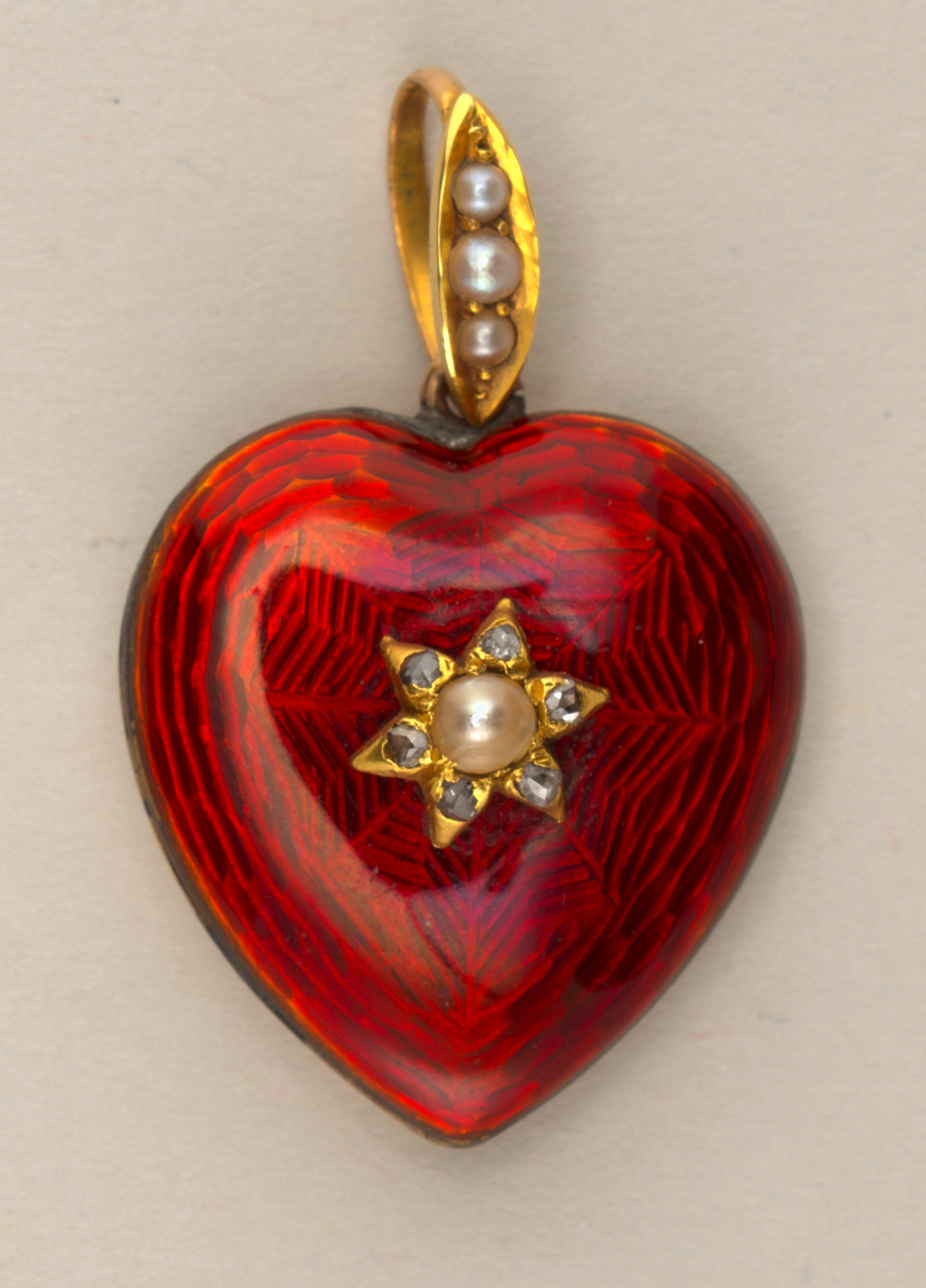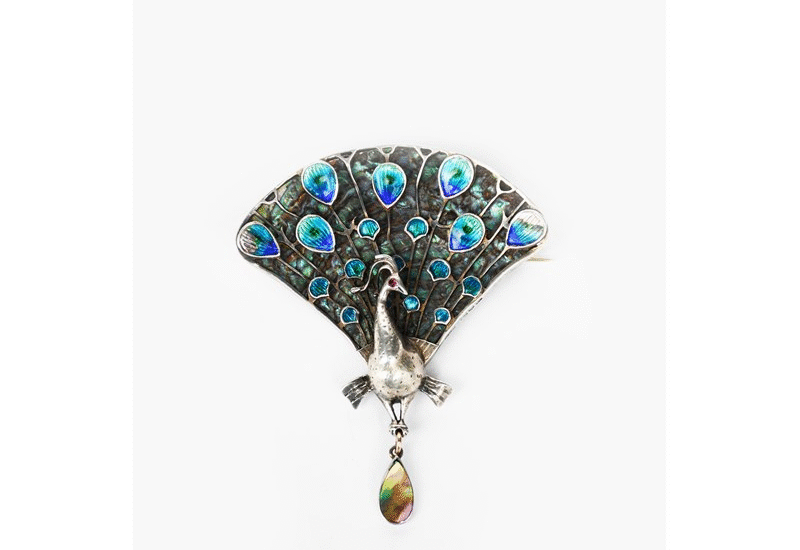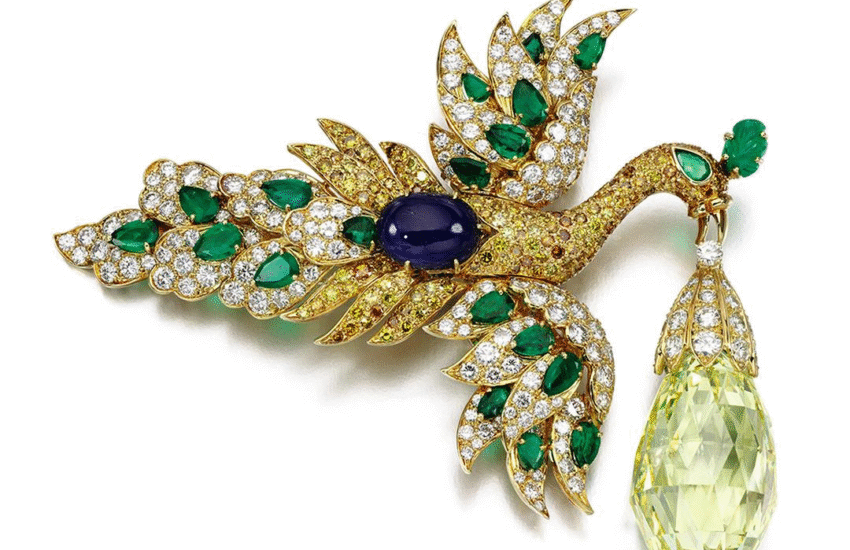What should I give my bridesmaids? A view from history.

Weddings are an expensive business and one of the puzzles facing the happy couple is ‘What should I give my bridesmaids?’ Luckily, taking a view from history can help. Nineteenth and early twentieth century magazines and newspapers can tell us a lot about bridesmaids’ gifts and the notions behind them.
Marriages, from the grandest royal weddings, to much more humble affairs, generally included a group of up to a dozen bridesmaids. These bridesmaids were young women, usually unmarried, who were asked to follow the bride down the aisle, hold her train and support her. As now, they often wore matching dresses and carried flowers to suit the wedding’s theme.
Innumerable lockets, bracelets and brooches
As a thank you for their efforts, the bride (in the United States) or the groom (in Great Britain) gave them a nice present. The best gift was one which was personal, reflected the couple in some way and which was suitable for any bridesmaid, regardless of age or size. Jewellery fitted the bill perfectly.
In fact, bridesmaids hoped to receive a lovely jewel and would be sadly disappointed if they didn’t.
A comic story in Judy or the London Serio-Comic Journal in 1883, called A Maiden’s Prayer, makes this clear. The woman writing in for advice complains that a recent wedding between a ‘great lord and a certain charming lady’ included no bridesmaids. She is horrified!
“What are we poor girls to do if the delightful – and, for a young creature like myself, becoming – office of bridesmaid is to be abolished?
I was living in hopes – are all the yearnings of my susceptible heart to be dashed to the ground for ever? What about the innumerable lockets and bracelets I fondly hoped to receive in the course of time? The thought is maddening!”
Luckily for other young creatures, plenty of couples included bridesmaids in their weddings. And, there were indeed innumerable lockets, bracelets and brooches.
Fashions for bridesmaids’ jewellery: hearts and arrows

Popular designs included hearts, like this little red enamel and pearl locket from the Smithsonian museum collection. Jewels often use a visual language. For this one, the red of the enamel suggests passion combined with the romance of the heart.
Jewellers’ catalogues listed pages of lockets and brooches, sometimes with a discount for buying half a dozen. The Sketch in 1893 showed a half page advert for jewellery, with a special focus on ‘elegant and exclusive novelties’ for bridesmaids. The pictures show an enticing array of hearts, arrows and horseshoes. The double heart-pin with pearl initials at the bottom of the page is particularly appealing.
Bridesmaids gifts to fit the wedding theme
Reports of weddings listed crystal heart shaped brooches and lockets, with the initials of the couple. A brooch for a summer wedding was perhaps decorated with roses, a winter one, with holly. Sometimes, a wedding was the perfect occasion for a fun, playful jewel. For example, a bridesmaid in a wedding reported in the Ladies Home Journal for 1891, received ‘a dainty little brooch…in the form of a small gold slipper, decorated with a wee bow of blue enamel.’
For a wedding in 1897, a bridegroom gave the bridesmaids ‘burgee brooches with the name of his yacht in emeralds on the white enamel. Sweetly pretty and nautical’. Yachting was an expensive and fashionable hobby which required special dress and accessories. The burgee which inspired the brooches was the flag of his yacht society and must have made a very smart jewel.
When Lillian Smith, the daughter of a sea captain, married Captain McLean, of the Australian steamship Woodonga, in 1904, she also chose a nautical theme. The marriage took place on the ship’s quarter deck. Lillian wore a pearl and diamond necklace with an anchor locket, the gift of the bridegroom. Her bridesmaids were in sailor dresses and carried anchors of flowers to match the gold anchor brooches Captain McLean had given them.
Lockets set with the portraits of the couple or decorated with their initials were also fashionable options.
Baby bridesmaids
The wedding of Miss Margot Tennant to Lord Asquith, in May 1894, brought a new innovation, according to Vogue magazine.
“The introduction of baby bridesmaids was also a novelty and one that was certainly picturesque…Having only children and quite a troop of them as attendants is…not half a bad idea. It must have been a saving to the purse of Asquith, as in England it is the custom to present each bridesmaid with a bracelet, and in this instance, the bridegroom had only to give his little attendants some small trinket.”
Child bridesmaids also received small pieces of jewellery like brooches and bracelets, just cheaper ones. Despite what Vogue believed, Margot Tennant was not the first to include children in her wedding. Rather she was following the same fashion as many other brides. Flower girls and page-boys became a common sight in many weddings.
Royal bridesmaids
Image Courtesy of Her Majesty Queen Elizabeth II
Like now, newspapers reported royal weddings in detail. The marriage of Queen Victoria to Prince Albert was a love match as well as a political alliance. Victoria and Albert planned many of the details of the day themselves, including Victoria’s sketch for the dresses of her lady attendants. Additionally, Albert designed turquoise-set eagle shaped brooches which he gave to each of the bridesmaids. The ladies who received these brooches treasured them and many of them were passed down through their families. Several still survive, including one in the Royal Collections.
The wedding of Princess May and George, Duke of York, 1893
Image Courtesy of Her Majesty Queen Elizabeth II
Bridesmaids at royal weddings could expect very grand gifts. George, Duke of York, gave a fabulous brooch to each of the bridesmaids when he married Princess Mary (May) of Teck on July 6, 1893. His mother, Queen Victoria’s diary lists the ’10 dear Bridesmaids: Victoria, Maud, Ducky, Sandra, Baby B., Thora, Daisy, Patsy, Alice Battenberg & Ena, the 4 little ones looking very sweet.’ Like Margot Tennant, May chose four little girls as attendants as well as her adult bridesmaids.
The success of the wedding must have brought as much relief as joy. May had been engaged to George’s brother, the Duke of Clarence and heir to the throne. His sudden death, just six weeks before their wedding, made May’s position very awkward. Marrying George solved her personal dilemma and gave Victoria an acceptable daughter in law.
The bridesmaids’ gift
The Royal jewellers, Collingswood, must have put a good deal of thought into the design for George’s gift to the bridesmaids. The Rose of York brooch, which could also be used as a bracelet centrepiece, is full of symbolism.
The enamelled white rose in the centre has been the symbol of Yorkshire since the Wars of the Roses of the 15th century. As the Duke of York, this was a very appropriate choice for George. The gold and gem-set crown at the top also refers to his dukedom. George was an officer of the Royal Navy, so the diamond anchor nods to his sea career.
May’s wedding dress was made of Spitalfields silk, embroidered with roses, shamrocks and thistles, like the little flowers and leaves on the brooch. The roof of her wedding carriage was decorated in the same way.
The wedding created huge excitement. Fans could buy copies of the brooch in London’s Burlington Arcade, for what Vogue magazine described as a ‘trifling sum’. They also reported that ‘the prettiest little ornament just now …is a tiny cluster lace-pin or brooch exactly representing in enamel and brilliants, the May-Blossom. It is as dainty, as well can be, and bids fair to become a lasting souvenir of the Royal wedding of 1893.’
An American heiress
When Flora Davis married Lord Terence Blackwood in 1893, he gave her bridesmaids a very carefully chosen gift. They received a ‘brooch consisting of a ruby heart inside the horns of a diamond crescent. The design is the badge of the Blackwoods and was therefore as appropriate as it was costly.’
Flora was the daughter of a wealthy American and Terence was following his father into the diplomatic service. They met at a breakfast party and married at the American embassy in Paris. By all accounts, it was a love match. When they delayed the wedding, due to negotiations over her settlement, Flora became quite ill.
Flora was a noted beauty. Her portrait, by the French artist Fernand Paillet, is now in the New York Historical Society. It was one of the ‘American Beauties’ commissioned by the collector Peter Marié.

Like many rich American brides, Flora chose her wedding dress and trousseau at Worth’s – the most fashionable Paris couture house. Her wedding dress was a combination of white lace and heavy ivory satin. Newspapers also described her going away outfit, made by Paquin, as ‘an ineffable combination of electric-blue velvet and chinchilla’.
A brooch for the bridesmaids
The brooch Terence gave to Flora’s bridesmaids was a neat summary of the marriage. Ruby and diamonds reflected the money which Flora brought to the couple, courtesy of her banker father. The diamond crescent, taken from the badge of the Blackwoods, referenced Terence’s title and estates.
This combination of British titles and American money was a classic feature of the late nineteenth century marriage market. Famous American beauties like Jennie Jerome (Prime Minister Winston Churchill’s mother) and Consuelo Vanderbilt, wife of the Duke of Marlborough, married into the British aristocracy with varying degrees of success.
A dainty souvenir: the bridesmaids’ jewel
For many young women, being a bridesmaid was a practice run for their own weddings. In Children of Cuba: a story of love and war, serialised in 1898, the heroine Coria waits for her sailor lover to return. When she’s given a gold locket and chain with the initials CC in pearls at her sister’s wedding, she views it as ‘a dainty souvenir when I too have passed through the golden gate.’ Coria daydreams about passing it down to her own daughter one day.
So, what lessons can history really offer us?
Through newspapers we learn that bridesmaids gifts were an essential part of any smart wedding. Jewellery was a great choice- classic romantic hearts and arrows were popular. But, couples also chose much more personal designs, inspired by their lives and interests. They used lockets and brooches with their portraits or initials, as well as designs taken from their family coat of arms or devices. Or, the bridegroom took inspiration from the seasons or from his hobbies or work. George, Duke of York or Captain McLean of the Woorunga steamship both chose nautical anchors for their wedding gifts. Flora Davis’s bridesmaids got a brooch with a heart for love and a crescent for the groom’s family arms.
To go back to our starting question: What should I give my bridesmaids? If we follow the view from history, something pretty, personal and wearable will go down well.
Jewellery and weddings go together, whether as gifts to bridesmaids or lovers’ tokens. However, this isn’t always straightforward. To find out about how a 19th century romance went badly wrong and ended with the police, read here.


